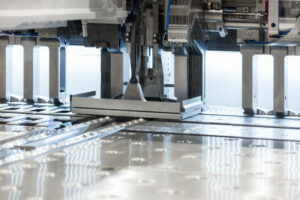On This Page
What is Metal Stamping?
The aerospace industry is one of great precision and high standards. With so much at stake with every flight, there is no room for error or ‘mishaps.’ The slightest mishap can result in significant financial loss, or even worse, the loss of life. When it comes to the manufacturers who help produce the necessary components to get flights off the ground, they are held to a very high standard and heavily scrutinized as they complete their work. While there are a number of different levels that go into aerospace manufacturing, perhaps one of the more notable is metal stamping.
 Metal stamping is a method of converting flat metal sheets into specific shapes. It can involve a number of metal forming techniques including punching, bending, and piercing, to name a few. This is a fairly intricate process, capable of making small parts. Most commonly this process is used to create fasteners and screws for the aerospace industry.
Metal stamping is a method of converting flat metal sheets into specific shapes. It can involve a number of metal forming techniques including punching, bending, and piercing, to name a few. This is a fairly intricate process, capable of making small parts. Most commonly this process is used to create fasteners and screws for the aerospace industry.
A variation of metal stamping is ‘deep-drawn metal stamping.’ Using deep-drawn metal stamping, flat sheets of metal are drawn into a die to form components. Those components involved in a deep draw display greater depth than width, thus the name, deep drawn stamping. As the component is redrawn through a series of dies, the width is further reduced, as length is increased. Components are also often deep-drawn partially to create different diameters throughout the part. In comparison to turned parts, which require more materials overall, this process lowers costs.
Stamping Methods
Below are listed some of the different methodologies used in the stamping process. As you can see with this broad list of strategies, there are a lot of ways to get your product customized to the necessary specifications for your project.
- Beading: Reducing or enlarging the diameter of a part by displacing the material.
- Bottom Piercing: Cutting a round or shaped section of metal from a drawn component.
- Bulging: Forcefully extending part of the diameter of the component from the original shape
- Coining: Displacing material to form specific shapes in the component
- Curling: Rolling metal under curling die to create a rolled edge.
- Extruding: A large diameter punch is used to push through a pilot hole and extend the metal.
- Ironing: The process of thinning the walls of components.
- Necking: Taking a section of a component and making it smaller than the rest of the component.
- Notching: Making a notch in the open end of the part.
- Rib Forming: Rib forming is the process of creating an outward or inward protruding rib on the part.
- Side Piercing: Piercing holes in the sidewall of the drawn component. The shape is dependant on the component’s specifications.
- Stamping: A method of adding identification to the part, such as the name of the supplier or a product number.
- Threading: Creating threads with a wheel and arbor.
- Trimming: Removing metal that was necessary for drawing the part from the finished part.
Fasteners used in the aerospace industry include anchor bolts, self-tapping screws, cotter pins, shims, and castle nuts. To create these customized pieces, deep-drawn stamping is a great route to take. This process allows for accuracy in the creation of these custom parts and covers a wide range of products, so there is versatility in this process.
 Aerospace Stamping Materials
Aerospace Stamping Materials
The material used in aerospace applications is always very important. Using the right materials for the job sets you up for success. There are many materials that can be stamped the following is a shortlist of compatible metals with this process.
- Aluminum 6061- Lightweight, strong, corrosion-resistant, and weldable.
- Titanium- Extremely strong and lightweight, corrosion-resistant, and heat-resistant
- Waspaloy- Resistant to high temperatures, corrosion from oil-based products, and overheating & frequent thermal cycling
- Inconel– resistant to high temperatures, age-hardenable, and highly tensile
Waspaloy and Inconel are two of our high-performing super-alloys most commonly used in the aerospace industry due to their ability to withstand high-temperature extremes and maintain resistance against deformation. This makes them a perfect choice for the high stress that aerospace construction inevitably creates.
Aerospace Professionals Near You
If you are looking to find Aerospace manufacturers in Ohio that you can work with near you, consider getting in touch with Wedge Products. They have provided quality metal stamping products on time and at a competitive price since 1933. Wedge is an aerospace-certified stamping company. They are well equipped to get your stamping needs met with their modern facilities and equipment, on time!
To learn more about the different types of Aerospace Manufacturing, click here.
